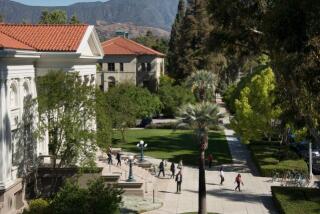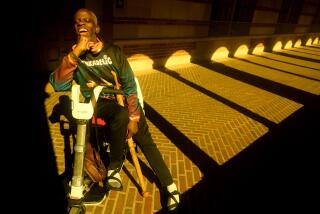Speeding Wheelchair Users Are Put on Notice
- Share via
Concerned for the safety of pedestrians on campus, Valley College in Los Angeles is cracking down on speeders by setting a new speed limit of 4 mph.
But the target isn’t errant motorists. It’s wheelchair users.
“Are you speeding on campus?” asks a flier recently mailed to disabled students. “If so, you could get more than a speeding ticket.”
In fact, offenders face being cited or even expelled, according to the campus office of disabled services, which imposed the new regulations. The speed limit is 1 mph faster than the average walking speed.
“It’s like a bad joke,” said Lynn Eller, one of several dozen students who navigate the Valley Glen campus by wheelchair or electric cart. “I don’t know which is more absurd -- the ticket or the fact that this came from the office that’s supposed to be helping disabled people.”
Administrators said they issued the policy this fall because more students are using motorized wheelchairs that can go faster but are also heavier and can cause serious injury if they hit someone.
“It’s a safety issue, pure and simple,” said Tom Jacobsmeyer, vice president of administration. “A speeding wheelchair can be just as dangerous as a speeding car.”
Although no collisions have been reported and no citations have been handed out on the 20,000-student campus, there have been some close calls, Jacobsmeyer said.
He asked the disabled services office to impose the policy after seeing a “very petite female student” stepping out of a classroom nearly get hit by another woman “going very fast” in a wheelchair. “They both made pretty exaggerated moves to keep out of each other’s way,” he said.
Two advocates for the disabled in California say they know of no reported injuries or problems caused by wheelchair users in crowded areas.
“This sounds like the bureaucratic impulse to regulate everything in sight,” said Deborah Kaplan, executive director of the World Institute on Disability in Oakland, a public policy think tank. “Do they also cite students who bump into each other in the hallways when they’re not looking?”
“This seems like a solution looking for a problem,” added Bay Area disabled-rights attorney Larry Paradis, a wheelchair user. “I’m just mystified as to why they picked this out among all the various hazards out there. People should not be talking on cell phones and reading while they’re walking.”
Officials said anyone on campus can go to the administration office and report someone barreling along too fast in a wheelchair. If a warning doesn’t work, alleged speeders will be cited under the student conduct code. “We’ll bring them in and say, ‘Slow down,’ ” Jacobsmeyer said.
Chronic offenders, however, can be reprimanded, suspended or expelled, said Kathleen Sullivan, coordinator of the disabled services office.
Eller, a 56-year-old Pacoima resident enrolled in computer courses, says campus officials have their priorities backward. “People who aren’t disabled should be warned to be considerate of wheelchair users.”
She wants a retraction of the policy and an apology for the flier, which states some wheelchair users are “putting other students at risk.”
Eller said other disabled students share her opinion and many at first thought the flier was a joke. “We figured they’ve got to be kidding that we might be a danger to somebody. In fact, we have to watch out for everybody else.”
Sullivan defended the flier’s message. “It had to be said because some people in their wheelchairs go fast through crowds,” she said. “It’s an awareness issue.”
She admitted, however, that some people are wondering what’s next.
A fellow administrator sent her a note that asked jokingly, “How about cracking down on the blind? A guy could get a poke in the eye with one of those white canes.”
More to Read
Sign up for Essential California
The most important California stories and recommendations in your inbox every morning.
You may occasionally receive promotional content from the Los Angeles Times.













